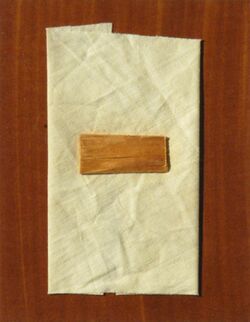Engineering:Personal preference kit
The personal preference kit (PPK) are containers used to carry the personal items and souvenirs of astronauts during the Gemini and Apollo programs and the Space Shuttle flights. Items that astronauts chose to carry into space were approved by NASA management and stored in PPKs.
Purpose and specifications
The Federal Aviation Regulations (as of January 1, 2001) defined personal preference kits with the following specifications:
A container, approximately 12.82 centimeters x 20.51 centimeters x 5.13 centimeters (5" x 8" x 2") in size, separately assigned to each individual accompanying a Space Shuttle flight for carrying personal mementos during the flight.[1]
Additionally, the Federal Aviation Regulations (as of January 1, 2001) limited the contents of PPKs to a maximum of 20 personal items that weigh a total of 0.682 kilograms (1.5 lb).[2] As of 2019, the Federal Aviation Regulations state that personal items to be contained in PPKs include "flags, patches, insignia, medallions, minor graphics, and similar items of little commercial value", and that these items must first be approved by NASA management.[3][4]
Astronauts were required to submit a manifest listing the items to be held in their PPKs,[5] as well as who was to receive the items, sixty days prior to their launch date.[6] After spaceflight missions, some personal items carried in PPKs are put on display, or given as awards to shuttle workers and VIPs.[7] One such item was the sphere of aluminum brought by Frank Borman in his PPK during the Apollo 8 mission, which was later used to strike 200,000 space-flown medallions that were distributed to certain NASA agencies and Saturn contractors that participated in the Apollo program.[8][9]
Usage in the Gemini program
The astronauts on Project Gemini spaceflights were authorized to bring personal items in only one PPK, which was a 6 in × 7 in (15 cm × 18 cm) nylon drawstring bag. Weight limits and the small amount of space available in the Gemini spacecraft limited the amount of items that could be carried in PPKs.[10]
Usage in the Apollo program
Similar to astronauts in the Gemini program, crew members on Apollo spaceflights were also assigned PPKs in which they could store personal items and souvenirs.[11] The PPKs were made from Beta cloth, a type of fireproof cloth that was added to Apollo/Skylab A7L space suits and used in other specialized applications.[12]
Five PPKs were carried on Apollo 11: one for each of the three astronauts were carried on Columbia, and two were carried on Eagle Lunar Module.[10] In a special arrangement with the United States Air Force Museum , Neil Armstrong brought wood from the propeller and fabric from the wing of first plane to achieve powered flight, the 1903 Wright Flyer, in his PPK aboard the Lunar Module, which were taken to the Moon on Apollo 11.[7][13][14]
As part of a joint NASA-USFS project, about 400 to 500 tree seeds from Douglas fir, loblolly pine, redwood, American sycamore, and sweetgum trees were stored in small containers in Stuart Roosa's PPK during the Apollo 14 mission. Upon his return to Earth, many of the seeds were germinated. Their seedlings were planted throughout the United States, Japan, Brazil, and Switzerland and grew to be the "Moon trees".[15][16]
For the Apollo 17 mission, the PPK was replaced with the astronaut preference kit (APK).[10]
References
- ↑ 14 C.F.R. 1214.601c as of 2001. Retrieved January 11, 2020.
- ↑ 14 C.F.R. 1214.604b as of 2001. Retrieved January 11, 2020.
- ↑ 14 C.F.R. 1214.601 as of 2019. Retrieved January 11, 2020.
- ↑ 14 C.F.R. 1214.604 as of 2019. Retrieved January 11, 2020.
- ↑ Kluger, Jeffrey (October 12, 2018). "What Neil Armstrong Biopic First Man Gets Right and Wrong About the Moon Landing". Time. https://time.com/5423099/first-man-moon-landing-neil-armstrong-ryan-gosling/.
- ↑ Stewart, Chris (May 7, 2019). "New batch of Neil Armstrong lunar landing artifacts up for auction". Dayton Daily News. https://www.daytondailynews.com/news/local/new-batch-neil-armstrong-lunar-landing-artifacts-for-auction/32QBvm2gCm5PURgIdHVtwO/.
- ↑ 7.0 7.1 Siceloff, Steven (October 24, 2007). "Items Taken into Space Reflect Accomplishments on Earth". NASA. https://www.nasa.gov/mission_pages/shuttle/behindscenes/Whatsgoingup.html.
- ↑ "Space / Astronautical Wing - 'Early Flights' Corridor". http://www.check-six.com/Museum/Space-m.htm.
- ↑ "FLOWN ITEMS". https://www.spacecollection.info/flown_items.html.
- ↑ 10.0 10.1 10.2 Spain, Chris. "Personal Preference Kits (PPKs)". http://spaceflownartifacts.com/flown_ppks.html.
- ↑ "Kit, Personal Preference, Apollo 11". Smithsonian Institution. https://airandspace.si.edu/collection-objects/kit-personal-preference-apollo-11.
- ↑ Sajewski, Lise, ed (2012). Falling to Earth: An Apollo 15 Astronaut's Journey to the Moon (1st ed.). Smithsonian Books. p. 139. ISBN 9781588343338.
- ↑ Waxman, Olivia B.. "When Neil Armstrong Went to the Moon, He Brought Souvenirs of the Wright Brothers' Flight. Now They're for Sale". Time. https://time.com/5418950/first-man-neil-armstrong-wright-flyer/.
- ↑ Hansen, James R. (2005). First Man: The Life of Neil A. Armstrong. Simon & Schuster. p. 527. ISBN 0-7432-5631-X. "He is most clear about, and most proud of, the pieces of the historic Wright Flyer that he took to the moon. Under a special arrangement with the U.S. Air Force Museum in Dayton, he took in his LM PPK a piece of wood from the Wright brothers' 1903 airplane's left propeller and a piece of muslin fabric (8x13 inches) from its upper left wing."
- ↑ Lehman, Eben (February 17, 2011). "Houston, We Have Moon Trees". Forest History Society. https://foresthistory.org/houston-we-have-moon-trees/.
- ↑ Williams, David R.. "The Moon Trees". NASA. https://nssdc.gsfc.nasa.gov/planetary/lunar/moon_tree.html.
![]() This article incorporates public domain material from websites or documents of the National Aeronautics and Space Administration.
This article incorporates public domain material from websites or documents of the National Aeronautics and Space Administration.
 |




